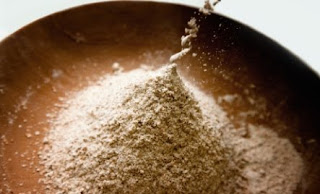When I found out I couldn’t eat gluten one of the things that really tugged my heart strings was that I had just gotten involved with baking and gourmet cooking. Take a look at your recipes at home, and you see flour added to the majority of dishes. Whether it is a thickening agent, main component, or sidekick, flour dusts itself all over the cooking world.
But that alarming circumstance immediately got me thinking and researching. I was restricted to only 2 flours in my cooking, and there is a flour world out there I have never even thought of touching. Flavorful flours that can bring something new to the table. Why couldn't I just substitute a flour I COULD eat in for the flour that I was allergic to?
Simple enough right? But with substituting comes unexpected outcomes. So with much experimenting and research, I have become much more comfortable over the last 6 months substituing different agents into my meals.
So with that said, I will give you the flour list that I have taken so much advice from in my baking adventures. Gluten free or not, I encourage you to expand your horizons in cooking! Any ol’ john doe can just reach for the white or wheat flour…
Potato Starch Flour
This is a gluten-free thickening agent that is perfect for cream-based soups and sauces. Mix a little with water first, then substitute potato starch flour for flour in your recipe, but cut the amount in half. It can be purchased in a health food store.
Tapioca Flour
This is a light, white, very smooth flour that comes from the cassava root. It makes baked goods impart a nice chewy taste. Use it in recipes where a chewy texture would be desirable. It would work nicely in bread recipes such as white bread or French bread. It is also easily combined with cornstarch and soy flour. It can be purchased in a health food store.
Soy Flour
This nutty tasting flour has a high protein and fat content. It is best when used in combination with other flours and for baking brownies, or any baked goods with nuts or fruit. It can be purchased in a health food store.
Cornstarch
This is a refined starch that comes from corn. It is mostly used as a clear thickening agent for puddings, fruit sauces and Asian cooking. It is also used in combination with other flours for baking. It can be purchased in a health food store.
Corn Flour
This flour is milled from corn and can be blended with cornmeal to make cornbread or muffins. It is excellent for waffles or pancakes. It can be purchased in a health food store.
Cornmeal
This is ground corn that comes from either yellow or white meal. This is often combined with flours for baking. It imparts a strong corn flavor that is delicious in pancakes, waffles, or simple white cakes. It can be purchased in a health food store.
White Rice Flour
This is an excellent basic flour for gluten-free baking. It is milled from polished white rice. Because it has such a bland flavor, it is perfect for baking, as it doesn't impart any flavors. It works well with other flours. White rice flour is available in most health food stores, but also in Asian markets. At the Asian markets it is sold in different textures. The one that works the best is called fine textured white rice flour.
Brown Rice Flour
This flour comes from unpolished brown rice. It has more food value because it contains bran. Use it in breads, muffins, and cookies. It can be purchased in a health food store.
Kamut and Spelt Flours
These are ancient forms of wheat. While they aren't appropriate for gluten-free diets, they are excellent substitutes for plain wheat flour as they add wonderful flavor and consistency.
Substituting Gluten
Wheat flour contains gluten, which keeps cookies, cakes and pies from getting crumbly and falling apart. It is what makes baked goods have a good texture because it traps pockets of air. This creates a lovely airy quality that most baked goods possess when baked with traditional wheat flour. In order to help retain this structure when using non-wheat flours, gluten substitutes must be added to a gluten-free flour mixture. For each cup of gluten-free flour mix, add at least 1 teaspoon of gluten substitute. Here are three very good substitutes for gluten.
Xanthum Gum
This comes from the dried cell coat of a microorganism called Zanthomonas campestris. It is formulated in a laboratory setting. This works well as a gluten substitution in yeast breads along with other baked goods. You can purchase it in health food stores.
Guar Gum
This is a powder that comes from the seed of the plant Cyamopsis tetragonolobus. It is an excellent gluten substitute and it is available in health food stores.
Pre-gel Starch
This is an acceptable gluten substitute. It helps keep baked goods from being too crumbly. This, too can be purchased at most health food stores.
Substitution is the solution
If you are ready to try some recipes, start with recipes that use relatively small amounts of wheat flour like brownies or pancakes. These turn out lovely and the difference in taste is minimal. Here are two gluten-free flour mixtures that are suitable for substituting wheat flour cup for cup.
•Gluten-Free Flour Mixture I
1/4 cup soy flour
1/4 cup tapioca flour
1/2 cup brown rice flour
•Gluten-Free Flour Mixture II
6 cups white rice flour
2 cups potato starch
1 cup tapioca flour
**list from allrecipes.com
Also check out your local whole foods store to find pre mixed flours!


No comments:
Post a Comment